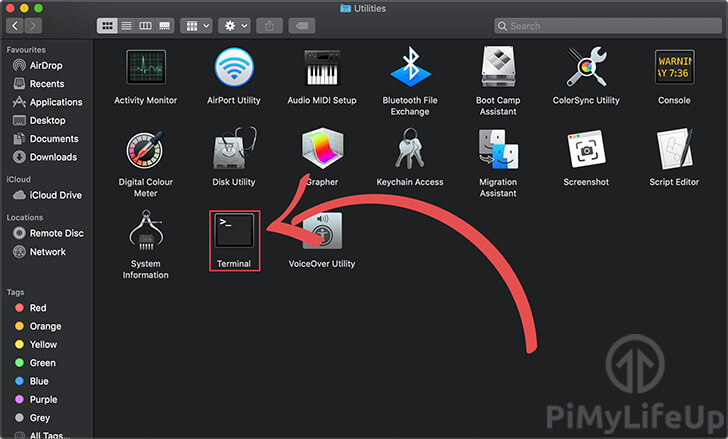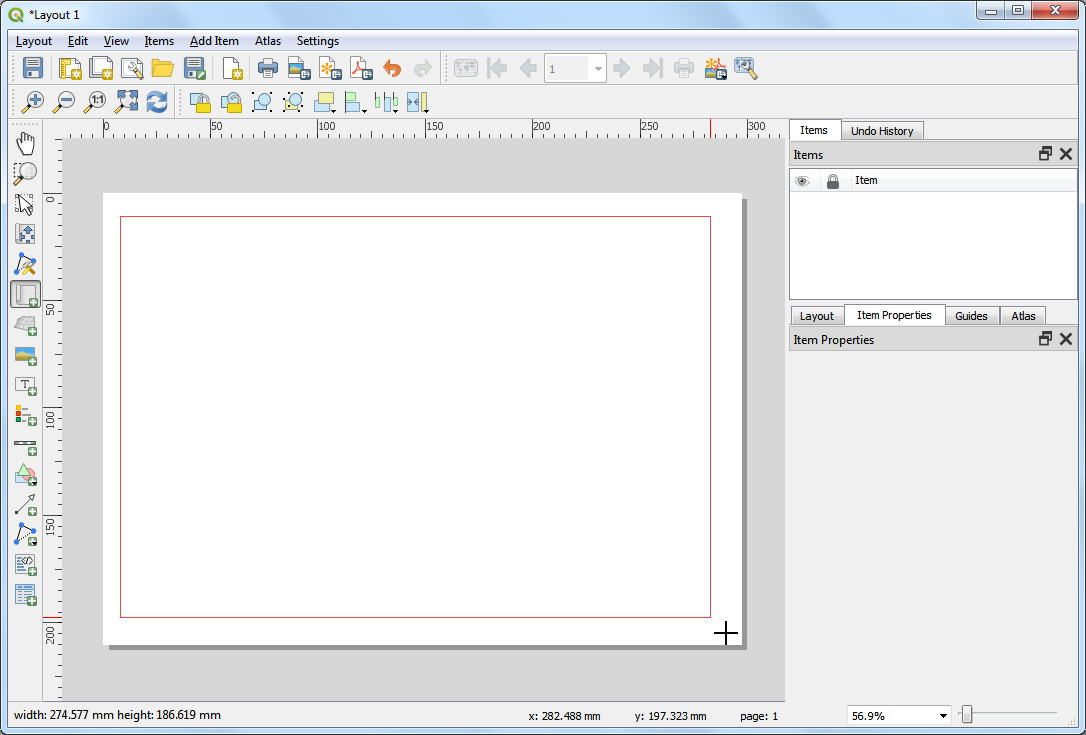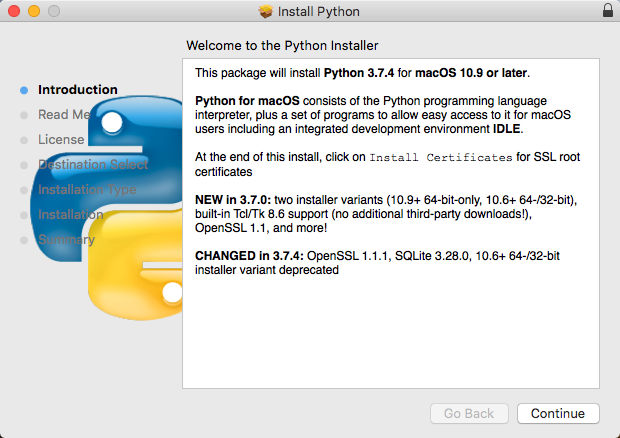I. What is MatplotLib and BaseMaps
Matplotlib and BaseMaps are python libraries used to display and manipulate data. MatplotLib is the basic package which allows the programmer to create graphs and plots in 2D and 3D (includining animation). The BaseMaps extension adds the additional capabilities to display data overlayed onto a 2D map or 3D globe. The combination of the two allows anyone with familiarity with python a quick and easy way to create analysis tools oor even just some quick visualizations.
II. Easiest Install
May 12, 2019 For most Unix systems, you must download and compile the source code. The same source code archive can also be used to build the Windows and Mac versions, and is the starting point for ports to all other platforms. Download the latest Python 3 and Python 2 source.
- How to install Python 3 on a Mac computer. On Mac the recommended approach is to use the official Python.org installer. Previously the package manager Homebrew was a great choice–it handled software installs and upgrades elegantly in most cases–but for Python itself there are several serious issues detailed by Justin Mayer in this post.
- To use TA-Lib for python, you need to have the TA-Lib already installed: Mac OS X $ brew install ta-lib Windows. Download ta-lib-0.4.0-msvc.zip and unzip to C: ta-lib. Download ta-lib-0.4.0-src.tar.gz and: $ untar and cd $./configure -prefix=/usr $ make $ sudo make install. If you build TA-Lib using make -jX it will fail but that's OK!
The easiest way to install both MatPlotLib and BaseMaps is to use DarwinPorts (http://darwinports.com/) or Fink(http://www.finkproject.org/).These applications are 'package managers' that will allow you to be able to download all sorts of free software packages for the Mac. You can install either or both applications (the available packages overlap quite a bit).
For Fink, you can install matplotlib and basemaps by running:
For DarwinPorts you can install by using this command:
In either case, this should install everything needed in order to use the python libraries. To test it, use the example presented below in this document.
This is by far the simplest method of installation. Manual installation isn't difficult but certainly takes a little longer.
III. Installing MatplotLib
If you want to do this a little more hands on, it's not much more difficult. First, you'll need to download four dmg files:

- Python 2.7.3:
- http://www.python.org/ftp/python/2.7.3/python-2.7.3-macosx10.3.dmg
- Numpy:
- http://sourceforge.net/projects/numpy/files/NumPy/1.6.2/numpy-1.6.2-py2.7-python .org-macosx10.3.dmg/download
- SciPy:
- http://sourceforge.net/projects/scipy/files/scipy/0.11.0/scipy-0.11.0-py2.7-pyth on.org-macosx10.3.dmg/download
- Matplotlib:
Install Python first. Then install Numpy and SciPy. Lastly, install Matplotlib. These are all dmg’s so they should automatically install everything. The installation will be done in the directory:
You will then need to set up your environment variables (.cshrc file for instance):
Install Glob For Python In Mac Free
Once everything is installed, create a new python script, cut and paste one of their examples into it, then try to run it. Here is the one I used:
from mpl_toolkits.mplot3d import Axes3D
import matplotlib.pyplot as plt
import numpy as np
fig = plt.figure()
ax = Axes3D(fig)
for c, z in zip(['r', 'g', 'b', 'y'], [30, 20, 10, 0]):
xs = np.arange(20)
ys = np.random.rand(20)
ax.bar(xs, ys, zs=z, zdir='y', color=c, alpha=0.8)
ax.set_xlabel('X')
ax.set_ylabel('Y')
ax.set_zlabel('Z')
plt.show()
This should display a 3D bar graph using transparency and multiple colors.
IV. Installing BaseMaps From Source
This gets a little trickier. There is no pre-built dmg file for installation, so this has to be downloaded and built.
Install Glob For Python In Mac Catalina
First, get the source from here: http://sourceforge.net/projects/matplotlib/files/matplotlib-toolkits/basemap-0.9 9.4/basemap-0.99.4.tar.gz/download
The size is about 100MB, but almost all of that is taken up by map data. Extract the source, then open a temrinal and navigate to the directory.
Before BaseMaps can be built, the GEOS library (nothing to do with the GEOS model) needs to be built. To do so, navigate to the GEOS directory and run configure like so: ./configure --prefix=some/path. After that, you run make and make install. This will create the GEOS libraries.
When the libraries are created, you will need to create a GEOS_DIR environment variable. The GEOS_DIR environemnt variable should match whatever path you used for the prefix when you ran configure. After the environment variable has been created, do a source or whatever action is required to make sure the variable is there.
Now you can go back to the root BaseMap directory and install BaseMaps. To do so, use the command: python setup.py install. This will finish the build process and install the necessary files and libraries to use BaseMaps. To test the installation, you can navigate to the exampless directory and run a few of them.
V. Installing BaseMaps From Binary Distribution
The setup.py script in BaseMaps gives an option to create a binary distribution. While this is not a self-installing dmg file, it creates a tarball with all the correct folder heirarchy and files for distribution. If you have a binary distribution, installation is easy. Extract the archive and then use cp -R to copy the folder to the root directory.
VI. Installing Python Image Library (PIL)
This is an optional package but may be necessary depending on whether or not you use certain image sources (see the bluemarble example in BaseMaps).
Install Glob For Python In Mac Version
Again, no binary distribution is available for the Mac so you'll need to build from source. Worse, the actual build fails on the Mac (but it can be worked around).
You can get the source here: http://effbot.org/downloads/Imaging-1.1.7.tar.gz
Extract the source. In a terminal window, navigate to the image library directory. Run python setup.py install. This will most likely fail. The failure arises from the script, which tries to build libraries for both PPC and Intel based machines. Unless you've explicitly installed PPC versions of the required libraries, the python script will fail.
The workaround is simple. There is only one file that this fails on. Copy the failed buid lines beginning with gcc, then paste them on the commandline. After that, go back and delete the -arch ppc part off the command. Once the file builds, re-run the the setup.py script. This should successfully build and instal the library.
To ensure that it installed correctly, you can go to the BaseMaps example directory and try running the bluemarble or warpimage examples.

Getting started with JupyterLab
The installation guide contains more detailed instructions
Install Glob For Python In Macbook
Installation with mamba or conda
JupyterLab can be installed with mamba and conda:
or
Note: If you have not installed mamba or conda yet, you can get started with the miniforge distribution.
Install Glob For Python In Mac Operating System
Installation with pip
If you use pip, you can install it with:
Install Glob For Python In Macro
If installing using pip install --user, you must add the user-level bin directory to your PATH environment variable in order to launch jupyter lab. If you are using a Unix derivative (FreeBSD, GNU / Linux, OS X), you can achieve this by using export PATH='$HOME/.local/bin:$PATH' command.
Run JupyterLab
Once installed, launch JupyterLab with:
Getting started with the classic Jupyter Notebook
Installation with mamba or conda
The classic notebook can be installed with mamba and conda:
or
Installation with pip
If you use pip, you can install it with:
Congratulations, you have installed Jupyter Notebook! To run the notebook, run the following command at the Terminal (Mac/Linux) or Command Prompt (Windows):
See Running the Notebook for more details.

Getting started with Voilà
Installation with mamba or conda
If you use mamba or conda, you can install it with:
or
For more detailed instructions, consult the installation guide.
Installation with pip
If you use pip, you can install it with: